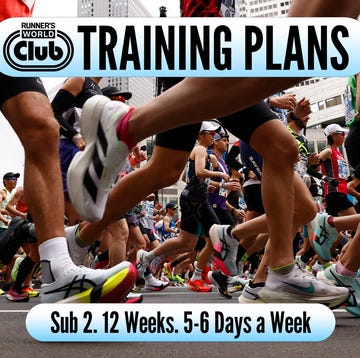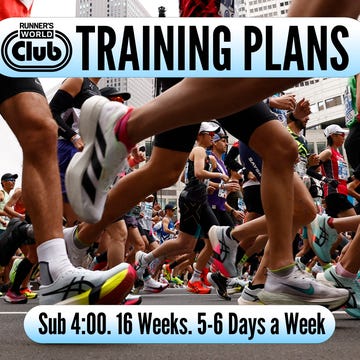Many people run for the endorphins and sense of achievement rather than the statistics. However, for several runners, dialling into fitness metrics is a big part of the process, as it helps to guide their training intensity and pinpoint areas for improvement. But which of these fitness metrics is the most important? Arguably, it’s VO2 max.
A measure of your aerobic fitness, VO2 max essentially shows the amount of oxygen that your body can effectively use during exercise. Oxygen – which is transported around the body via red blood cells – is vital for energy production, since the mitochondria in our cells use it to transform energy stored in muscles into the fuel required for movement. The more oxygen that you can process, the greater your ability to produce energy aerobically – and this means that you can run harder or for longer before tipping into anaerobic intensities.
VO2 max is presented as a number – or ‘score’ – and represents the maximum amount of oxygen that a runner can consume in millilitres per kilogram of body weight in one minute (mL/kg/min). Although that might sound confusing, it boils down to this: the higher the number, the better your VO2 max.
What everyone's reading
‘A high VO2 max is like a car with a bigger engine,’ says Matthew Meyer, a coach for Mile High Run Club in New York City. ‘A car with a smaller engine has to work harder to go as fast as the big engine.’
What is a good VO2 max score?
As ever with running, it’s relative – and your VO2 max score is be influenced by various factors. For starters, your VO2 max generally declines with age and males tend to have higher scores than females, while genetics (more on that shortly) also influence VO2 max numbers. What’s more, working at higher altitudes can result in lower VO2 max scores and even the method that you use for testing VO2 max (again, more on that in a moment) can affect your reading.
According to The Physical Fitness Specialist Certification Manual, though, a ‘good’ VO2 max score is 33-36.9 for females aged 20-29 and 42.5-46.4 for males aged 20-29. Scores naturally go down with age, while ‘excellent’ and ‘superior’ scores are obviously higher than ‘good’ ones for each age and gender category.
As for truly superior VO2 max scores, just turn to the elites. Marathon great Eliud Kipchoge has been known to have a VO2 max near 90, while the highest-ever recorded VO2 max score, a huge 96.7, belonged to Norwegian cyclist Oskar Svendsen. Back to more reasonable territory and sub-3 marathon runners tend to have an average VO2 max of 65.5, while runners who can complete a marathon in three hours or more hover around 58.7.
As noted by Silvano Zanuso, director of the medical and scientific department at Technogym, understanding your VO2 max can help you to identify other useful parameters like your heart rate zones and anaerobic threshold. You can then more effectively tailor your training around these zones and thresholds.
How do you measure your VO2 max?
Lab tests
To obtain the most accurate VO2 max score, you’ll need to do a test on a treadmill at a performance lab, specialist gym or medical centre.
In these tests, you start running on the treadmill at an easy pace. The intensity is then soon ramped up in set increments – either by increasing the speed or the gradient – until you can no longer physically continue.
Each test tends to last between 10 and 20 minutes. Throughout, you’ll wear a mask that’s hooked up to a machine that measures your oxygen consumption. Once you’ve reached your limit, the machine will measure your 60-second maximum oxygen intake, which is divided by your weight to calculate your VO2 max score.
Running watches
As accurate as lab tests may be, the caveat is that they are both costly and uncomfortable, which is why many runners don’t do them and seek readings from wearables instead.
Some running watches include a feature that estimates your VO2 max score based on your personal training data – like your heart rate, mileage and altitude – and other metrics like your age and weight. This feature paints a good picture of your aerobic fitness, but it’s still worth noting that any figure that you obtain from a running watch is likely to be an underestimation of your true VO2 max. A running watch will be less accurate than lab conditions and we very rarely hit the top end of our capacity while working out on an everyday basis.
DIY tests
If you want to estimate your VO2 max without going to a lab or using a running watch, you can try your own tests at home – we've rounded up the best three tests here.
What are the benefits of having a high VO2 max?
Beyond assisting your running performance, having a high VO2 max could help you to live longer, with a 2022 meta-analysis finding a strong association between cardiovascular fitness and all-cause mortality risk, where the better your VO2 max, the lower your risk of death.
An article published by Harvard Medical School backs this up, adding that ‘increasing your VO2 max is associated with a reduced risk of heart disease, diabetes, cancer and stroke’.
If that’s not enough, a study from 2018 suggests that increasing your VO2 max will derive more benefits than improving other factors such as your smoking status and blood pressure.
How do you improve your VO2 max?
Running sessions
On the road or track, you’ll have to push your limits with tempo runs, threshold runs and interval sessions to boost your VO2 max. ‘The one thing that it teaches you is how to become a better athlete,’ says running coach Greg Laraia. ‘If you want to take your performance to the next level, or if you’re stuck in a rut and trying to figure out what’s wrong, a VO2 max test will teach you how to customise your training to break out of that rut.’
HIIT workouts
Although aerobic exercise will help you to maintain your VO2 max score, improving it requires putting in the hard yards – namely, high-intensity interval training (HIIT). HIIT forces you to reach or temporarily surpass your anaerobic threshold – where your body generates energy without oxygen – before returning to a lower, aerobic intensity. This type of overload causes your heart and lungs to adapt to the demands that you’re imposing on them and, over time, improves your VO2 max by increasing their capacity and efficiency.
VO2 max-boosting HIIT circuit
Perform as many repetitions as possible of the moves below in 30 seconds, resting for 10 seconds between each one. After you’ve completed all five exercises, rest for one minute before repeating the entire circuit again. Complete four rounds in total. Once you’ve mastered this, add another 10 seconds of work to each move until you reach 60 seconds for each one.
Is there a limit to VO2 max improvement?
Ultimately, your VO2 max does have a ceiling and there are only so many mountain climbers or interval sessions that you can do before you eventually plateau. That’s because genetics, as mentioned earlier, play a big role in aerobic potential, which is why we can’t all break two hours for the marathon like Kipchoge. However, this doesn’t mean that you should throw in the towel before you’ve even started – very few people ever hit their limits, so that there’s plenty of scope for improvement, regardless of your starting point.













